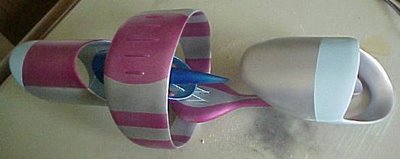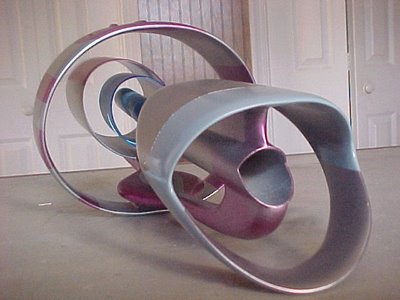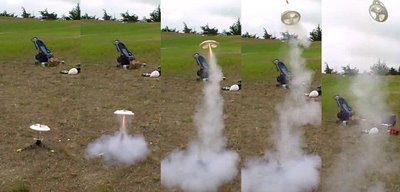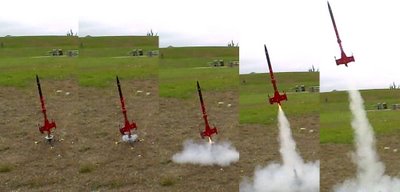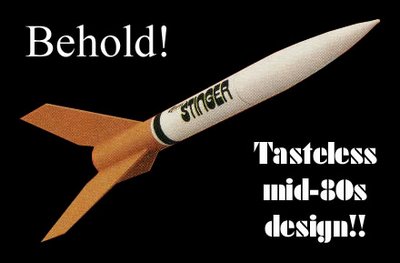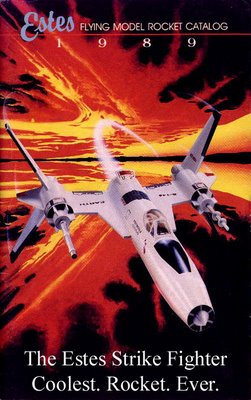April 28 launch

Had another launch yesterday with the crew from August. It was a beautiful day and we had some beautiful flights. The photo above shows my RPG rocket (on the right) with an Estes Space Bus and an X-15. The RPG's nose is made from cardboard decoupage cones and the ring fin is the cardboard tube from a roll of packing tape.
I had taped the nose cone shut for painting, and like an idiot I forgot to take the tape off before launch. The RPG had a beautiful boost to about 300 feet, at which point the ejection charge blew out the motor and the rocket pranged into some woods on the other side of a hill! Of course I had to paint the damn thing green. So I figured it was just gone. Either we'd never find it, or it would be total hamburger if we did locate its remains. But to my amazement the rocket was found intact. The body tube is a little bent, so the nose cone is no longer in perfect alignment with the tail (as you can see in the above photo), but it turned in two more beautiful flights--without tape.

This was my first time launching off a multiple pad setup, which allowed us to have some races. Here the Space Bus scoots off the pad on a 1/2A much faster than the D12-3 can get the RPG moving.

One of my star performers for the day was the Currell Graphics V2, which turned in three great flights. On the first flight the parachute failed to open but the rocket came down fine. I realized that this is a paper rocket and the parachute is really overkill. So I took it off for the next two flights, and the rocket came down just fine both times.

Yesterday was my first time to launch the V2 on C motors, and it performed beautifully.

The real star of my show was the Cheese Wheel (formerly known as the Laughing Cow saucer), of which I have two, one for 18mm motors and one for 24mm motors. I launched the 18mm one by itself on a C, launched them both together with CHAD staged D12-0 to A8-3 and again with D12-0 to C6-3. Perfect flights every time, slow and noisy--real crowd pleasers.


This was my first time staging anything, and I'm very happy with how well it worked.

This is not my rocket, but one of my rockets has a part in its story. This is a giant rocket made from a PET soda bottle with an 18mm motor mount in what was the bottle's spout. The trouble is, this thing is too darn big for an 18mm motor to push. She turned in two flights on C6s. Both times she only made it up to about 20 feet before heeling over and flying right into the ground. Neither crash was very violent because the rocket was traveling so slowly and such at a low altitude to begin with.
After some judiciously applied masking tape patched the damage from the first two crashes, we were discussing the possibility of a third launch. I volunteered to use the 24mm Cheese Wheel as a booster to get the thing moving fast enough that a C motor might do some good.

So we did that. Problems started as soon as this Frankenroc cleared the pad. As in the first two flights, it was going too slowly for the fins to stabilize it. It may look fast in the photo above but actually it was moving very slowly, about the speed of a Frisbee. So it started to lean over, and the leaning continued as it accelerated. By the time it was going fast enough for the fins to keep it flying straight, it was pointed horizontally.

Here we are right after booster separation. The Cheese Wheel is the black dot behind the PET rocket. Notice that the latter is now pointed down. It flew right into the hillside under thrust, this time from an altitude of perhaps 75 feet.

The aftermath. This is the coolest smashed rocket I've ever seen. Often the nose cone is trashed and the body tube may have one or even two strong bends, but this thing is on another level entirely. A couple of the bends in the body tube are foreshortened in this view; it actually buckled in four different places. The last remains of the red nose cone are peeking out the front. We decided it looked like a sad vulture.
Naturally, the Cheese Wheel came back with no damage.
Well, that's all for now. No more blogging for me until the dissertation is done.



